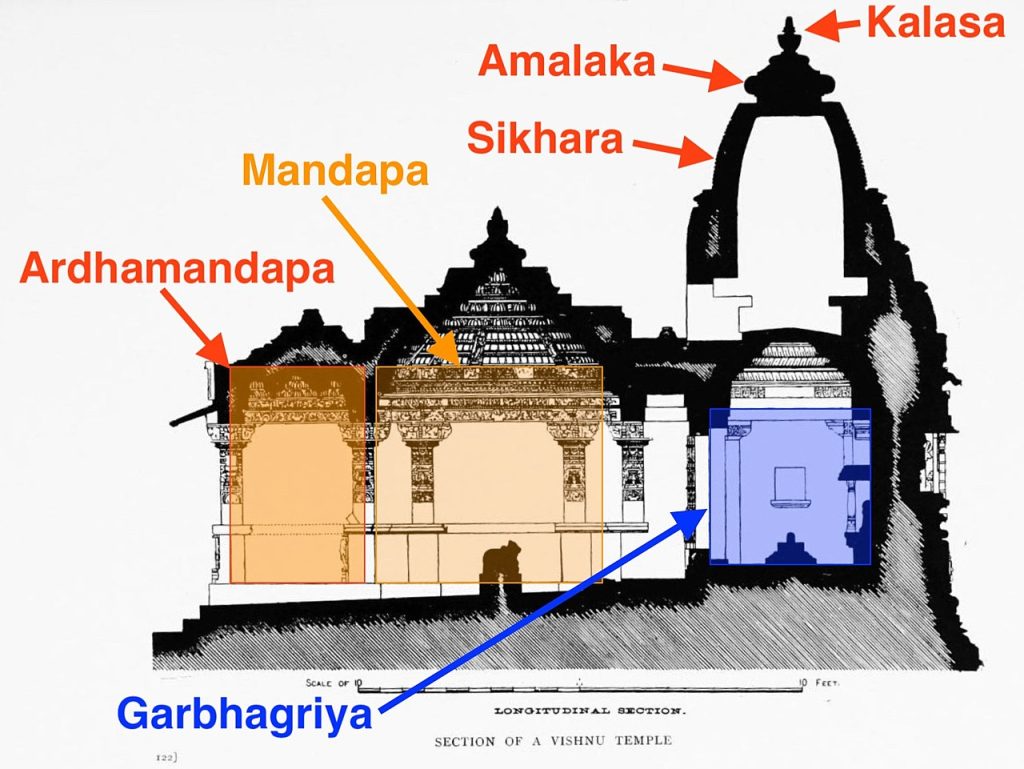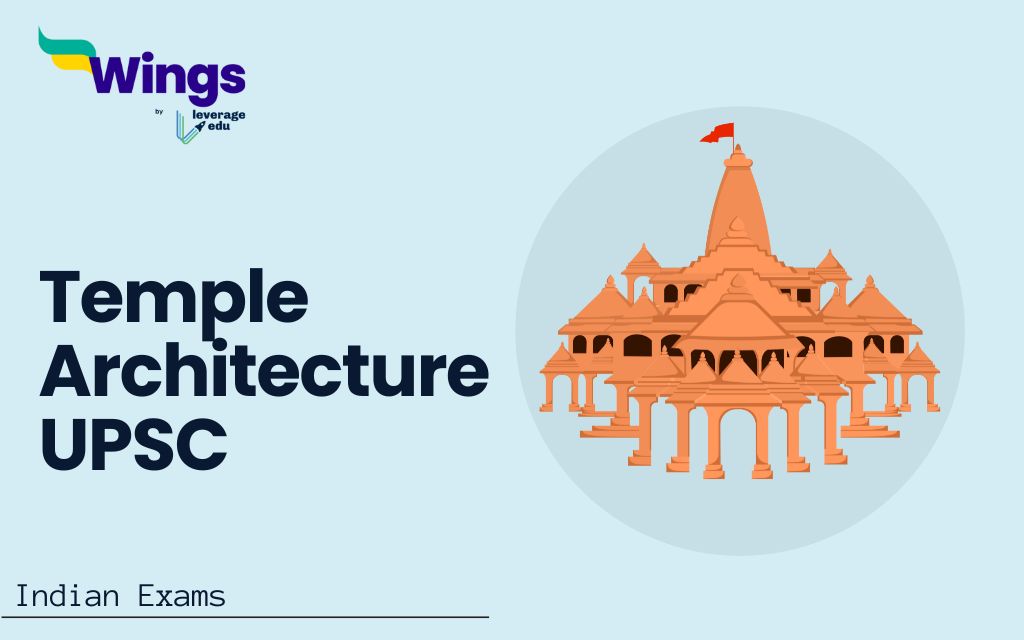The Indian subcontinent has a rich tradition of cultures and traditions, and this heritage is best reflected in its temple architecture. They are not just places of worship, but proof of the deep-rooted faith of the Indian people. Today, we will try to explore the prominent styles of Indian temple architecture from the perspective of Art & Culture syllabus: temple architecture UPSC. We will also focus on their unique characteristics and significance for UPSC aspirants.
Contents
Temple Architecture UPSC: Common Elements
While regional variations exist, most Indian temples share some core elements:
- Garbhagriha (Sanctum Sanctorum): The innermost chamber, considered the most sacred space, houses the main deity.
- Shikhara/Vimana (Tower): The towering structure above the Garbhagriha, symbolizing the mountain abode of the deity.
- Mandapa (Hall): A pillared hall leading to the Garbhagriha, used for congregational gatherings and rituals.
- Gopuram (Gateway): An ornately decorated entrance tower, often found in South Indian temples.
- Sculpture and Reliefs: Depictions of deities, mythological stories, and intricate floral patterns adorn the temple walls and pillars.

The Two Pillars: Nagara and Dravidian Styles
Temple Architecture UPSC can be broadly categorized into two main styles:
- Nagara Style (North Indian): Predominant in North, Central, and West India. Key features include:
- Shikhara: Curvilinear spires with a smooth, rounded appearance, often topped with an amalaka (disc-like ornament).
- Rekha-Prasada: The most common type of shikhara, with a square base tapering to a point.
- Lower Enclosure: Unlike Dravidian temples, Nagara temples typically have a lower enclosure with smaller gateways.
- Examples: Khajuraho Temples (Madhya Pradesh), Lingaraj Temple (Odisha), Brihadisvara Temple (Tamil Nadu – built by a North Indian dynasty)
- Dravidian Style (South Indian): Predominant in South India. Characterized by:
- Vimana: Multi-storeyed pyramidal tower with a distinct horizontal division.
- Gopuram: Monumental gateway towers, richly decorated with sculptures and mythological scenes.
- High Enclosure: Temples are often enclosed by high walls with multiple entrances.
- Examples: Meenakshi Temple (Madurai), Brihadeshwara Temple (Thanjavur), Virupaksha Temple (Hampi)
Must Read:Largest Temple in the World: The Angkor Wat Temple
Exploring Other Styles of Temple Architecture
The rich culture of Indian temple architecture extends beyond the Nagara and Dravidian styles. Let’s understand some unique regional variations:
- Vesara Style (Deccan Region): A mix of Nagara and Dravidian elements, seen in temples like the ones at Belur and Halebid (Karnataka).
- Kalinga Style (Odisha): Characterized by curvilinear towers with a vault roof, evident in the Konark Sun Temple.
- Maru-Gurjara Style (Rajasthan): Known for intricately carved pillars, balconies, and gateways, as seen in the Dilwara Temples (Mount Abu).
- Hemadpanthi Style (Western India): Developed by the Yadava dynasty, these temples showcase black stone and intricate sculptural details (e.g., the Simhasana Temple, Shani Shingnapur).
Must Read:Mysore Painting: History, Technique and Motifs
Temple Architecture UPSC: Significance
Understanding temple architecture goes beyond aesthetics. Here’s why it holds significance with respect to art & culture syllabus of temple Architecture UPSC:
- Every element, from the layout to the sculptures, has symbolic meaning, reflecting the underlying religious beliefs and philosophies.
- Temples offer a window into the social, political, and economic conditions of the era they were built in.
- The engineering and craftsmanship displayed in these structures are very inspiring.
- Temples are living expressions of India’s rich cultural heritage, creating a sense of community and belonging.
North Indian Temple Architecture
This section provides a chronological overview of North Indian temple architecture, highlighting important periods, example sites, and significant architectural features characteristic of each era.
| Period | Example Sites | Architectural Features |
| Post Mauryan | Bairat, Vidisha | Structural temples |
| Early Gupta | Sanchi, Baigram, Bhumra, Nachana Kuthar | Garbhagriha and mandapa structure supported by pillars, flat roof |
| Later Gupta | Deogarh, Bhitargaon | Mahabodhi Temple at Bodhgaya, Rekha shikhara, cruciform plan, Panchayatan style (square sanctum with pillared portico) |
| Post Gupta | Laxman Temple in Sirpur, Chattisgarh | Further development with richer ornamentation |
| Early Medieval | Odisha, Khajuraho, Rajasthan, Gujarat, Kashmir | Zenith of North Indian temple architecture, intricate ornamentation |
| Late Medieval | Kashmir, Ahom, Vallabhi | Minor regional styles emerged |
South Indian Temple Architecture
This section provides a chronological overview of South Indian temple architecture, highlighting important dynasties, example sites, and significant architectural features characteristic of each era.
| Dynasty | Example Sites | Architectural Features |
| Pallavas | Mahabalipuram (Mandapas, Rathas) | Early rock-cut mandapas, emergence of Dravida elements in Rathas |
| Cholas | Chidambaram (Nataraja Temple), Thanjavur (Brihadeeswara Temple) | Temples as administrative centers, rich ornamentation |
| Pandyas | Madurai (Meenakshi Temple) | Zenith of rock-cut architecture |
| Kakatiya | Warangal (Ramappa Temple) | Unique architectural style, Ramappa Temple known for intricate sculptures |
| Vijayanagar | Hampi (Virupaksha Temple, Vitthala Temple) | Fusion of Dravida and Islamic styles, cultural and artistic richness |
| Nayaks | Srirangam (Ranganatha Swamy Temple), Madurai (Meenakshi Temple) | Garuda shrine at Vitthala Temple, continuation of Dravida style |
Relevant Blogs
| Ellora Caves | History of Indian Art |
| 5 Most Famous Types Of Paintings in India | Traditional Art Forms of India |
| All the Names of India Throughout History | Tribes of India |
FAQs
Styles include Nagara, Dravida, Vesara, and Gopuram, reflecting regional variations in India’s temple architecture.
Typically includes a sanctum sanctorum (garbhagriha), a hall (mandapa), and a tower (shikhara) atop the sanctum.
It defines the distinctive regional or cultural characteristics in design and construction of religious structures.
Kalinga, Rekha Deula, and Pidha Deula are prominent styles, known for their unique designs and architectural details.
This was all about the “Temple Architecture UPSC”. For more such informative blogs, check out our UPSC Exams Section and Study Material Section, or you can learn more about us by visiting our Indian exams page.
 One app for all your study abroad needs
One app for all your study abroad needs














